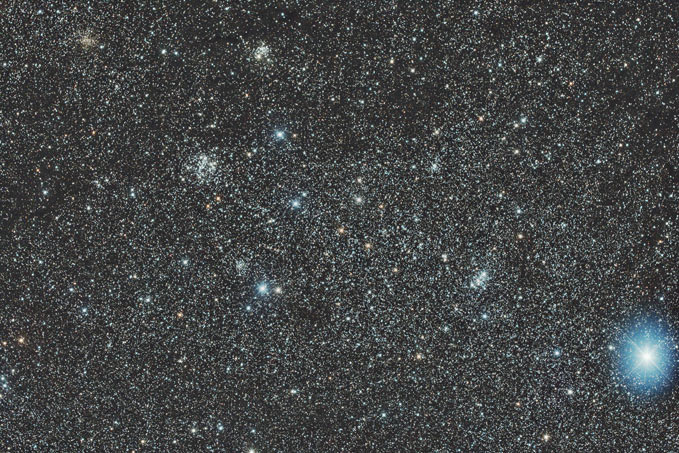| Date & Time: | Aug 11 2024, from 26:42 to 27:22 JST(+0900) |
| Composed 6 shots with 8 minutes exposed |
| Optical: | TAKAHASHI 16cm(6.3") epsilon (f=530mm, F3.3) |
| with LPS-D1 Light-pollution suppression filter |
| Auto-guided with TAKAHASHI JP Equatorial & SBIG STV |
| CMOS Camera: | ZWO ASI2600MC Pro (Cooled temp.: -5°C) |
| Location: | Ooizumi, Hokuto city, Yamanashi pref. |
| NGC663 / Open Cluster, type e, II 3 r |
|---|
| R.A. | 01h 46m 0.0s (2000.0) |
|---|
| Dec. | +61° 15' 00" (2000.0) |
|---|
| Apparent Size | 11' |
|---|
| Real Size | 8 light yrs. |
|---|
| # of Stars | 80 |
|---|
| Magnitude | 7.1 |
|---|
| Distance | 2570 light yrs. |
|---|
|
| M103 (NGC581) / Open Cluster, type d, II 2 m |
|---|
| R.A. | 01h 33m 11.9s (2000.0) |
|---|
| Dec. | +60° 42' 00" (2000.0) |
|---|
| Apparent Size | 5' |
|---|
| Real Size | 6 light yrs. |
|---|
| # of Stars | 25 |
|---|
| Magnitude | 7.4 |
|---|
| Distance | 3740 light yrs. |
|---|
|
Around between δ and ε Cassiopeiae, several open clusters are scattered and can be enjoyed only with small binoculars.
A large cluster at the left hand side of the image is NGC663, gathering plenty of faint stars in 11 arc minutes.
Apparent shape of the cluster looks like a triangle through scopes.
And a tiny open cluster at the lower right-hand side of the image is M103, it's wonder that NGC663 wasn't registered in the Messier's catalogue in spite of that NGC663 is larger and brighter than M103.
Last, this picture shows you more faint cluster of NGC654 at the upper part of the image.
You can find much more pretty open clusters around this celestial field, they will jump into your field of vision one after another.
|

